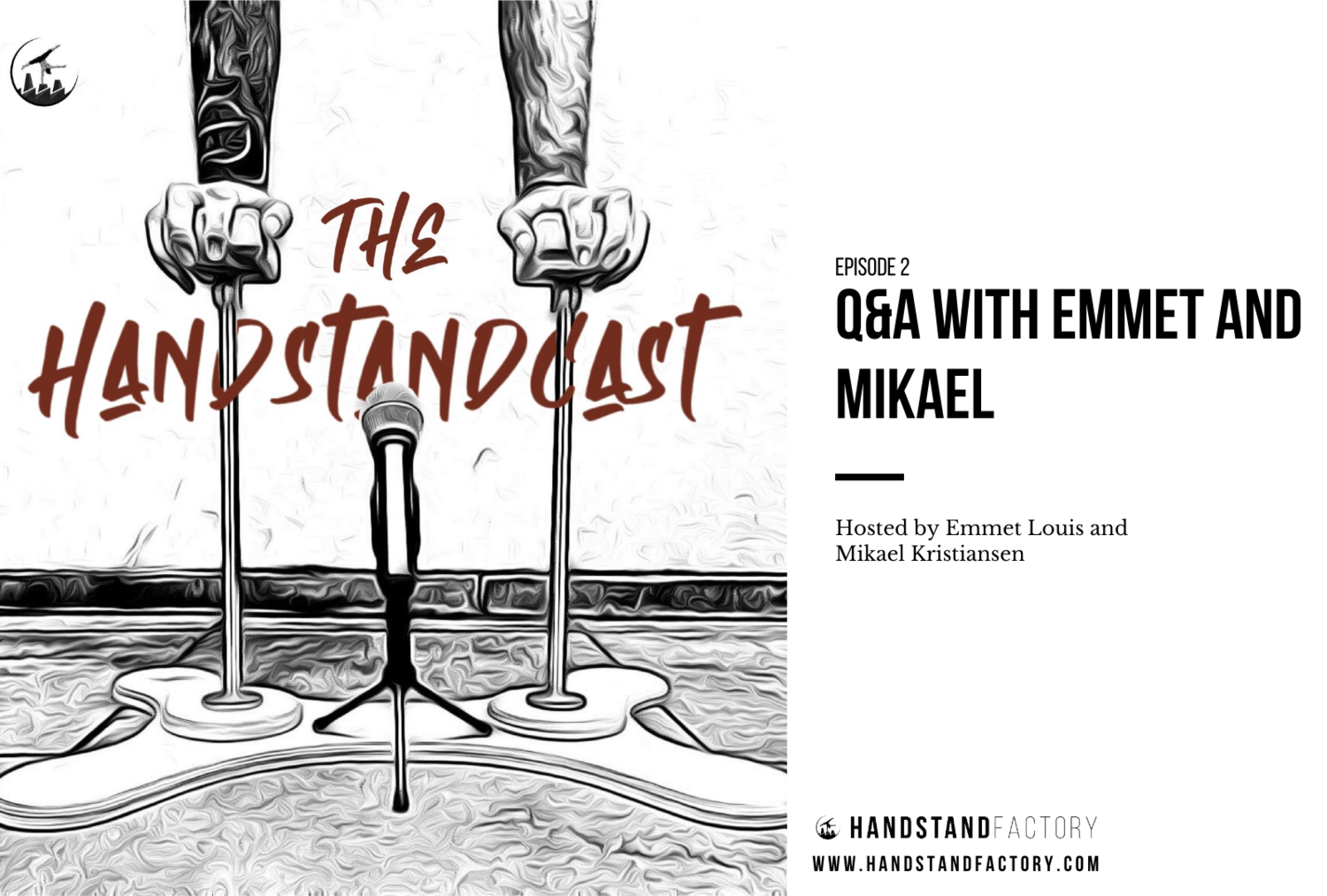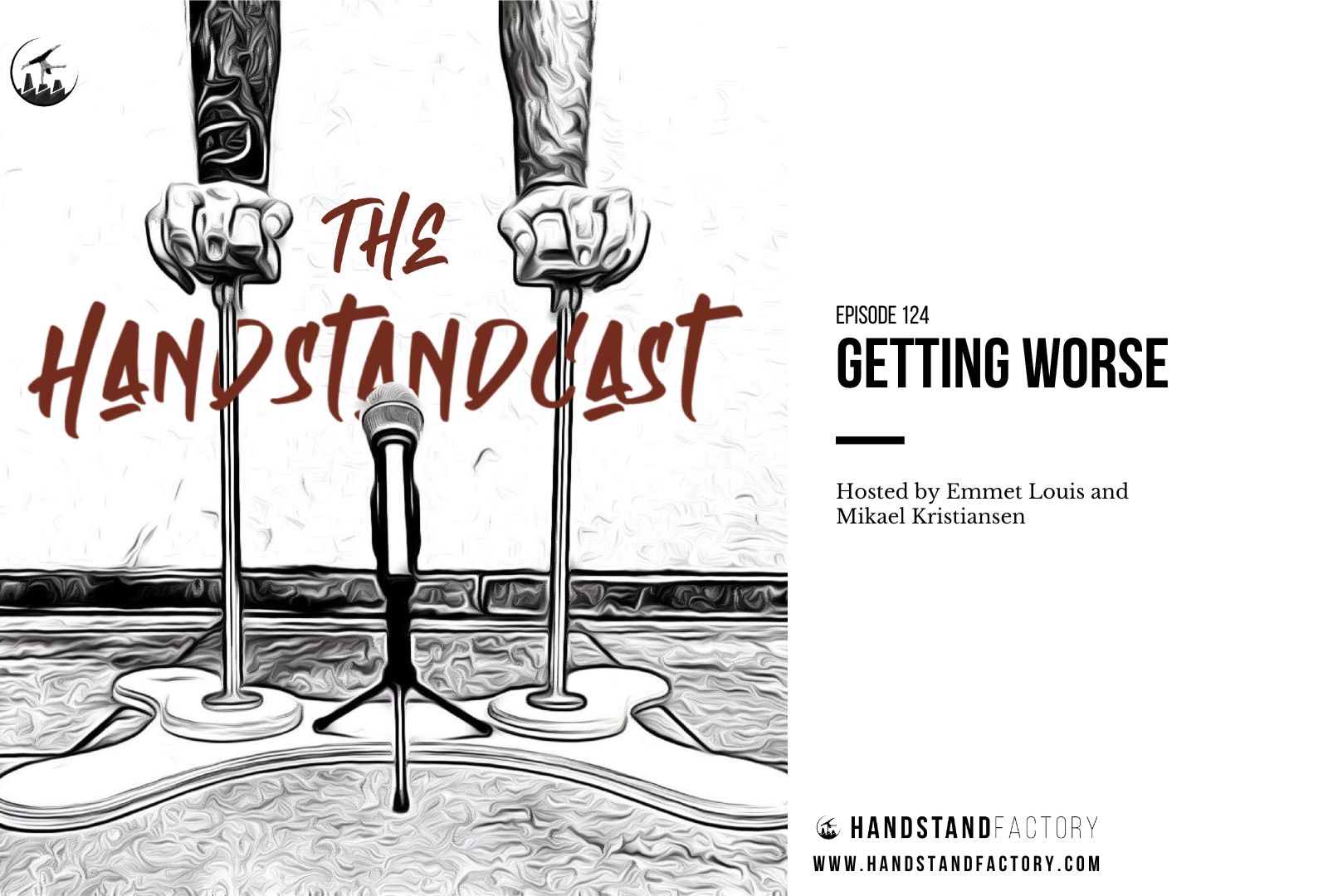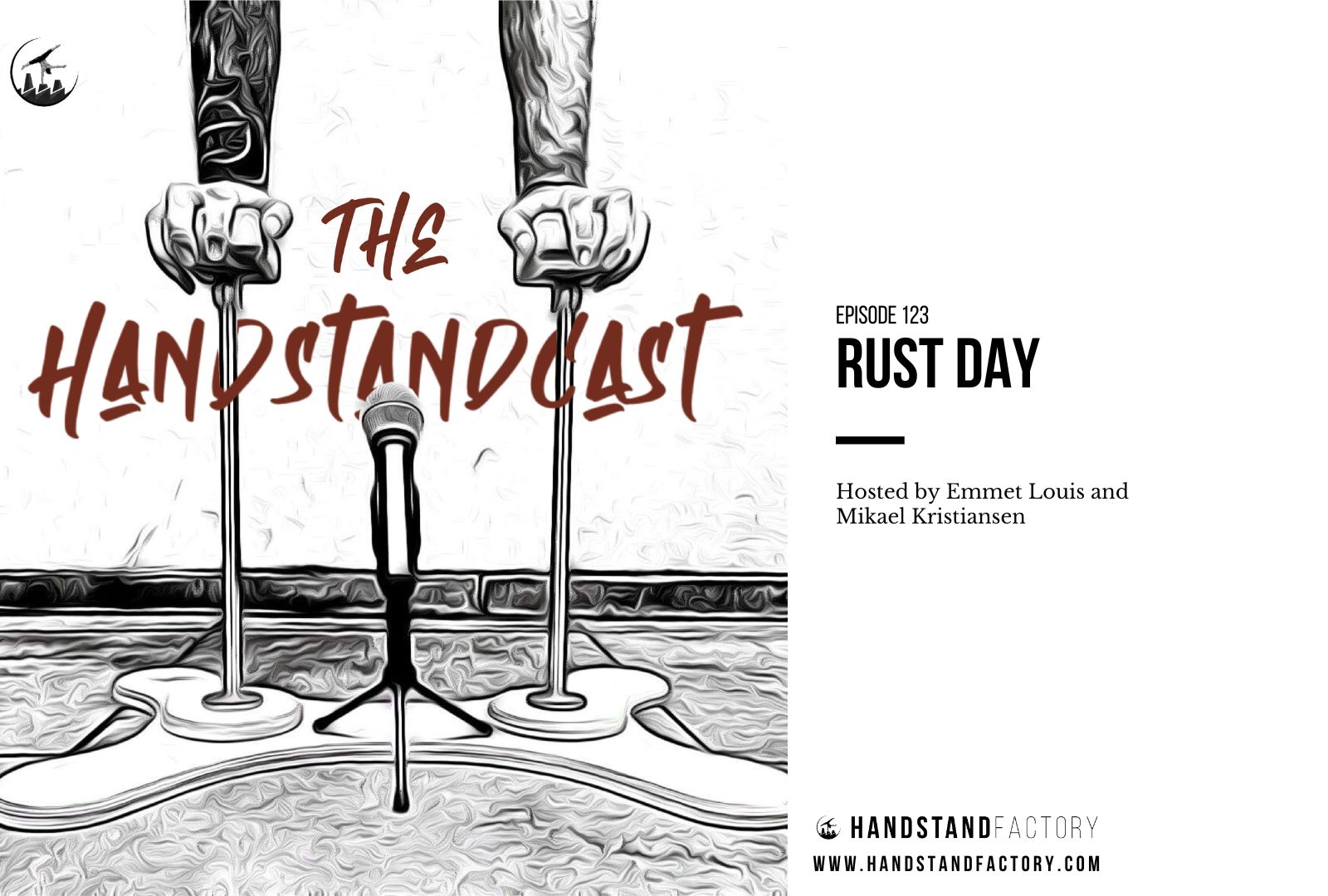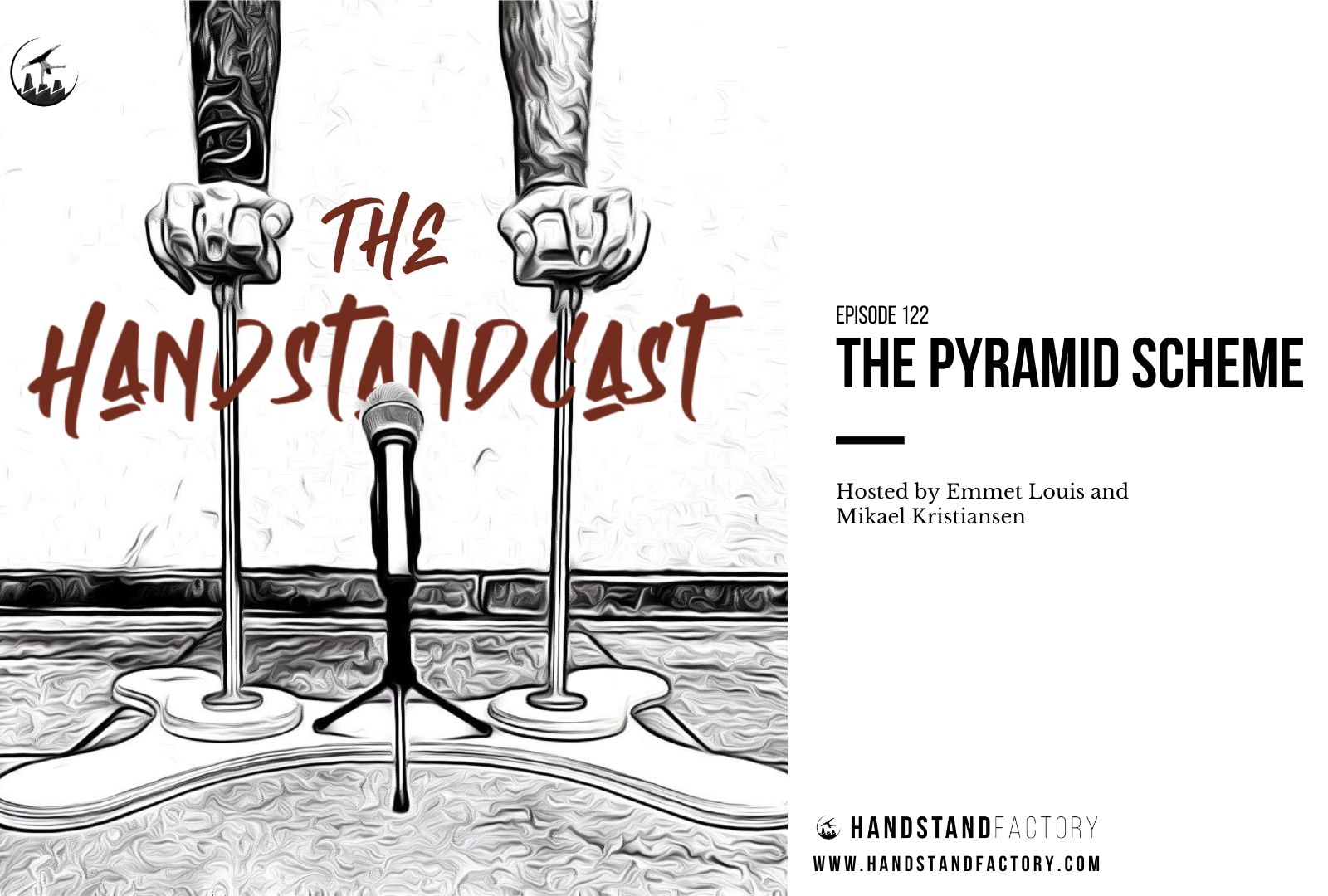
Hi and welcome to our second Episode of The Handstand Factory Handstandcast – a Podcast where Mikael Kristiansen and Emmet Louis talk all things handbalancing.
This is this episode, a quick Q&A from Emmet and Mikael using questions submitted by our Handstand Factory followers on instagram!
The Handstandcast – Season 1 will air every week. Topics we’ll cover over the first season include the straight handstand, the mindset of handbalancing and coaching handstands, though to be honest we’re making it up as we go along, so who knows where it might go!
S1E2 – Q&A with Emmet and Mikael
Love the podcast? We’re 100% coffee fuelled, so if you’d like to help keep us going you can easily support the Handstandcast by buying us a coffee here:
 Buy me a coffee
Buy me a coffeeThis podcast is brought to you by Handstand Factory, and is produced by Motion Impulse. To keep up with our weekly episodes, and help us spread the word, make sure to follow and subscribe to the Handstandcast wherever you listen to podcasts!
Love the podcast? We’re 100% coffee fuelled, so if you’d like to help keep us going you can easily support the Handstandcast by buying us a coffee here:
 Buy me a coffee
Buy me a coffeeTranscript of Episode 2: Q&A with Emmet and Mikael
EL: Hello, welcome back to the first of our series of Minisodes. What the hell is a minisode, really?
MK: I don’t know, it sounds like a ridiculous fucking term to me.
EL: How about maxisode? Maximum content, minimum amounts of soda?
MK: It’s essentially another rant by Mikael Kristiansen and Emmet Louis about handstands. Here we are.
EL: This minisode will be dealing with some of your questions. So we have a very advanced system for sending questions over. Some are arriving by carrier pigeon, and definitely not SMS. Definitely not SMS.
MK: The best way for later episodes, if you want to have your questions discussed between me and Emmet, is either message us things on social media you want us to speak about, or just wrap a piece of paper around a brick and throw it in one of our respective windows.
EL: You can also use the contact form on the Handstand Factory website, and use the title “Podcast Questions.” Questions are always an interesting thing. I kind of made a joke towards the end of the last episode that if your question is good, we’ll read it out. If your question is bad, we’ll read it out with your name attached. We’re not going to be that mean if your question is bad, we’re just going to tear it to pieces and crush your soul… So let’s see, shall we get to our first question that I’m totally pulling out of a hat? I’m going to start with this one, to show the level of questions we get. It’s a degenerate question. This degenerate wants to know: Mikael, can you pee in a handstand without getting it in your mouth? If so, what shape is best?
MK: I’ve never tried peeing in a handstand. I’ve drunk beer in a handstand; you just do a head through and have someone pour it into your mouth. Kind of miserable, but it works. Peeing, however, I think you would end up in a rather sad and wet state, unless you do it in a Mexican.
EL: Depends on how you arch it. If you do an Mexican and it arcs the right direction…it could just dribble down your chest and go straight to face.
MK: I think you would have to whip it the other way. At least as a guy; this wouldn’t work out as a girl. If you do enough Mexican, you should be able to get it to go the other way. If it’s deep enough.
EL: If your Mexican is definitely south of the border
MK: Mine isn’t….
EL: Are you in Texas, or are you in Mexico?
MK: Mine is still in Toronto…I’m not going to try…I don’t do Mexicans.
EL: I think Planche would be superior for peeing.
MK: Definitely, it’s probably the best one. Now, being strong enough to actually finish peeing – you’d need a damn good planche.
EL: Yeah I think the saying is it takes 21 seconds to empty the bladder for most mammals.
MK: You have a pretty solid planche if you can pee in it for 21 seconds. I’ll leave that challenge to any one of you out there, because I can’t hold a planche for that long, nor would I try to pee in one.
EL: I suppose you could one arm though, hold it.
MK: That would probably work, but probably still end up miserable.
EL: The hard bit, I suppose, is trying to tap the drips off.
MK: You’re going to have piss on your face, piss on your chest, and piss everywhere.
EL: How does it work for women, as well? Men have this kind of hose that gives it an aim, but for girls, how would that happen? You can see Elise, our producer, is turning slightly red.
MK: At least as a woman I’d assume you’d have to push a lot harder to make the stream go away from you, but I don’t know. I don’t think it’s a great idea, regardless. I think we’re moving on.
EL: Maybe that’s why everyone talks about using your core in a handstand, in case this situation pops up. Next question. You get to ask one now.
MK: How are the workouts divided up in the press program, please?
EL: The Press program. We cover three main components in it, where we split the Stalder press up into two sections. We’re going to talk about it in another podcasts in more depth. But we have high pressing, feet and hands on basically the same plane up to the straddle handstand. Then low pressing, pressing from a straddle L-Sit or L-Sit to where your feet cross your hands. Then we also have flexibility. Our own belief is you can start working on things that will lead to the Stalder at the same time, regardless of your level, even if you’re a complete beginner. We’ve put in a selection of workouts. You can find the appropriate level for you for flexibility, press: high press and low press. You have a few options. Combine them together into one big workout, and it’ll take about an hour to do that workout with all three components. Or, you can spread them throughout the week. Say, work high press Tuesday and Thursday, and work low press Wednesday and Saturday, then flexibility after leg day. You’re doing leg day, right?
MK: I don’t. I’d like to add onto that. The rationale is basically that the lower part of the press, the low press, moving from the Straddle L or L-Sit up to the standing position, and then the standing position up into the handstand are two different components, in terms of strength and muscle activation, control, etc. So it makes sense to train those two pieces separately, simply because what you want when you are training is to put the appropriate working volume and intensity onto your body. When you’ve done so, then you rest. Then you do that again, and hopefully you’ll have done the appropriate amount and level of intensity. Then you’ll be gaining strength slowly and consistency, and building up your press through that. Now, if you’re simply trying to work a full press, meaning you work both the high and low ones – which is appropriate when you’re strong enough and actually have it – you won’t be able to target the ranges as much. Being able to then separate those two things, because one is essentially protraction and depression strength, which is the low pressing, where you will need a tuck planche and that type of power. The load’s in front of the shoulders, lats, delts, etc. Then you have the high pressing, which ideally won’t be using as much of the delts, and biceps, and frontal pushing chain. It’ll be more upper back and traps. So being able to separate these two things is essentially structurally what we’re working on. We’re adding flexibility into this so you’ll be using less strength over time as you get better.
EL: Good overview. If you’re interested we do have the program online at Handstand Factory, where you can go from zero to hero. Which leads into…I suppose we haven’t yet described the manual, which is the sandwich. You have to make your sandwich with the components you want. This is kind of how it’s arranged. I’ve got my three components. I’ve got the bread, got the filling. The filling is the one you would make as the main workout you need to focus on. If the low press section takes the most energy, you do that first. You do your high pressing, or vice versa. Or if you’re super stiff, you might need to work the flexibility first as the meat. Then you put the bread on with the pressing sections. It’s very customizable; it’s what I like about it. Despite what people say, there is no one way. You just have to find what works.
MK: Everyone who starts this kind of stuff will come with different levels of various things. You might be a monster at pushing from an L-Sit up, but don’t have a standing press to handstand. Or it could be the opposite. You might be really stiff and strong, or flexible yet have no strength, etc. This is the rationale and thought process behind having this. You can also have a great handstand but very little pressing strength, or no handstand but loads of pressing strength. Variables exist out there, so this kind of structuring is an attempt at being able to tailor it. Nobody can know everyone’s variations; there’s just way too many. I’m not trying to rant too much on it, but I had, and I think most coaches who started out teaching handstands early, you won’t just be able to account for all these ridiculous amounts of variations. It took me like 5 years of teaching to be like, I need to stop using these cues. There’s just way too many variations. You get people who just go, like, I…can’t. There is a type of elbow structure variation; it can’t be classified as a disorder at all. It’s just a variation. It’s a bone structure, and if you have that, you may have to go about things slightly differently. It is what it is. It’s not something where you can have a one size fits all approach to it.
EL: Do you want to ask the next question?
MK: Let’s see. Is the Push Harder program a must before working on the Press program?
EL: No, I’d say the Press program is kind of a must for working on the Push Harder.
MK: To a degree at least. At least with the high press, you should be reasonably good before there’s much of a point of starting to do that.
EL: A lot of the prep elements, I suppose you could work harder, like the head in and chin in stuff, that will cross over to the press, and the press will cross over to them. But…the programs can be taken singly or mixed.
MK: The program structure, to quickly recap them: you have Push, the basic handstand program leading from either from not having a handstand into having a handstand, and then refining it. Or it could be having a handstand, and refining that handstand. The template’s based on where you can tailor it, to whether or not you’re good balancing and have a lot of the average strength you need. Or maybe you lack the flexibility, or the opposite. Then you have the Keep Pushing program, which leads from being able to do a handstand and having a reasonable amount of control standing with the alignment and how it works, to being able to move your legs, do the tuck handstand, do the straddle handstand, do the various entries, which are the jump entries. If you think about how this relates to press, and you’ve learned to jump into a straddle into a handstand, you can hold a straddle handstand. You can hold a tuck handstand. You can jump into a tuck handstand, and so on. You can control your legs, which means that you’re to some degree able to start learning that, or negative press, for example. Because you can hold a straddle, you can enter with a jump, which is a press with a jumping component and speed attached to it. That means, okay, you’re likely to have a low level of pressing strength. This leads you to the Press program. The Press program is separated into two parts. You don’t need a lot of low pressing to be able to work on the one arm. Unless you have a decent amount of high pressing strength, or are close to holding a pike handstand and so on, it’s good to have these things before continuing to push on, to working on the straddle and one arm handstand. This is the foundation level for advanced handstands.
EL: Push Harder is kind of the equivalent of Push, for one arm practice. From zero to hero. Other question. We have – which is the best stretch for the hip flexors, the long lunge, or the couch stretch? It’s a false dichotomy, because there is no best stretch for your hip flexors. There are only the targets for your own individual restrictions. What you will find particularly in this one is that if your Rectus Femoris is tight, the quadriceps – that will limit hip extension. Then, the couch stretch is best to target that. If your Rectus Femoris isn’t the restriction, then the lunge is good. But generally I advise a combination of working both of them at the same time. It’s common with a lot of programs I write to be doing something with the knee flex, and then something with the leg straight and the hip in full extension, or as close to full extension as you can get. It’s also one of those things where it’s depending on the limit. You might feel the stretch work somewhere else, but then you clear up a limitation and everything else opens up in hip extension. It’s one of those things that’s variable from person to person, more so than other kinds of positions. A forward fold is pretty straight forward for most people. There’s not that many specific limitations that are outside the norm. There are about ten different muscles involved in hip flexion. If one is a restriction, it will feel like all of them are restricting it. There’s a lot to play with, but the goal would be to do both.
MK: One more question that I had here, is how do you deal with rotation in a handstand? That’s a very common question. It’s not something you need on the beginner to intermediate level of handstands, because you’re mostly dealing with the two dimensional plane of backwards and forwards. Forwards is falling towards the finger side of the hand, over balance. Under balance means falling towards the heel side of your palms, and back to where you started. Rotation comes into play when you are starting to learn the lateral dimension of handstands, which is more on the Push Harder side of how we’ve structured it. Rotation is an interesting concept, because it’s very counter-intuitive in terms of what is happening. It’s also one that leads into the classic misunderstanding of the midsection side of things. Rotation happens in, say, a one arm handstand, or side shifting towards a one arm handstand. What will happen for most beginners is that as they start the shift, like from a straddle handstand where their feet are perfectly in one line in space, and the handstand looks reasonably good and the shoulders are stacked. Then they start leaning over to the side. Even if they do this with very proper set up, where they’re able to get into the diagonal alignment, as we talk about, where you bring the leading leg (left leg when on left arm) down to the floor – not a deep flag, but you’re setting up a diagonal layer. What happens to most people is that as you do this, this perfect line between your feet in space that you have with two arms in your straddle might not transfer so well as you start this movement. You’re moving into new territory where you don’t know what you’re doing. The likelihood of those two legs of yours staying exactly on the same plane is unlikely. You might be starting some sort of rotation from your hip. The interesting thing is it’s very hard to fix it from the hip. Regardless if the twist starts from your hip, or your shoulder, you’ll need to fix it from the shoulder. As your centre of mass starts moving out from your base of support, this rotation starts happening. You need to be re-establishing your shoulder underneath that, then putting the leg back in place. The most common thing that happens, actually, is you lean over and the movement moves correctly at first. But loads more weight comes onto your arm that you’re not used to having, and this destabilizes the shoulder. You won’t even see it. That little destabilization leads to the shoulder moving slightly. Then it manifests further up in the chain, and exacerbates in the legs starting to move out of shape. You see the top leg opening at the hip flexor and going backwards.
EL: I find a lot of what you’re looking at as well is when you shift the weight over, people tend to not push directly into the ground, but push back. Maybe the increased weight starts recruiting some flexion of the shoulder. It’s 5mm of a difference, but then the shoulder goes from a stacked position to slightly more open. Then it sets up that chain. The shoulder is more open, there’s no point of contact with the ground, basically. If you look at the back, you see the arch going diagonal from shoulder to opposite hip. Then it’s gone, it’s lost.
MK: Yeah, this rotation sounds a bit confusing. But rotation relates to the one arm handstand, as arching relates to the two arm handstand. The arching being a result of a suboptimal shoulder position, where the shoulder sinks a bit more than it needs to, causing the arch. That is kind of the same that happens. When you add this third dimension in space, especially in the straddle position, there is very little likelihood that both legs will fall into arch at the same tempo. What happens is the top leg will take over that beginning, and then spiral out of control. The main thing you need to know in countering and dealing with this, is getting good. You just have to practice, get strong in the area, get understanding and so on. Be very aware, and this comes back to the previous question; if you don’t have a press, very little control in under balance and very little control in a solid straddle handstand – if you start leaning over, your legs will start spinning – you will have very little understanding of the control. When you’re really good at this, and have a one arm handstand and are stable, you can do all kinds of twisty positions. You just place the leg and the shoulder won’t collapse as a result of it.
EL: Placement first, everything else second. Moving on to our last question, who has a better chance of surviving on a deserted island (or desert island?); Mikael or Emmet?
MK: Emmet, I think.
EL: You’d just forget to gather food.
MK: Yeah, I would probably survive for a while and then get wrecked. We both would get wrecked though.
EL: Look at our skill sets. We’re not very practical people. What do you do? Stare at the floor all day.
MK: I’m good at handstand; how could I be good at survival?
EL: It’s not a known discipline for survival. Maybe if there were locals on the island, or natives, we could entertain them enough to win some food, possibly they wouldn’t eat us. You look like a skull.
MK: There’s not that much meat on me. They could eat my traps though, that’s probably very nutritious.
EL: You’d probably just be gristly and too lean.
MK: I guess that wraps up our Q&A session for this time. As we said, throw a brick through our window with a note attached to it with your questions. Or alternatively, do it on social media. It’s slightly easier and cheaper for our sake, and maybe also for you in case we catch you.
EL: It’s going to cost you, so remember to check us out, @handstandfactory on Instagram, @mikaelbalancing, or @emmetlouis. If you’re interested in our programs or learning anything, check out handstandfactory.com Other than that, see you next week.
References
- Emmet and Mikael speak about the different Handstand Factory online programs, you can find them here.
- In the question about hip extension stretches, Emmet speaks about the long lunge, here is a video of his about it: Go to YouTube
- If you are generally interested in hip extension and front split flexibility, the front split deep dive video with Emmet can be found here: Go to YouTube
- Handstand Factory courses
- Emmet Louis Instagram
- Mikael Kristiansen Instagram
- Handstand Factory Instagram
- Anchor



